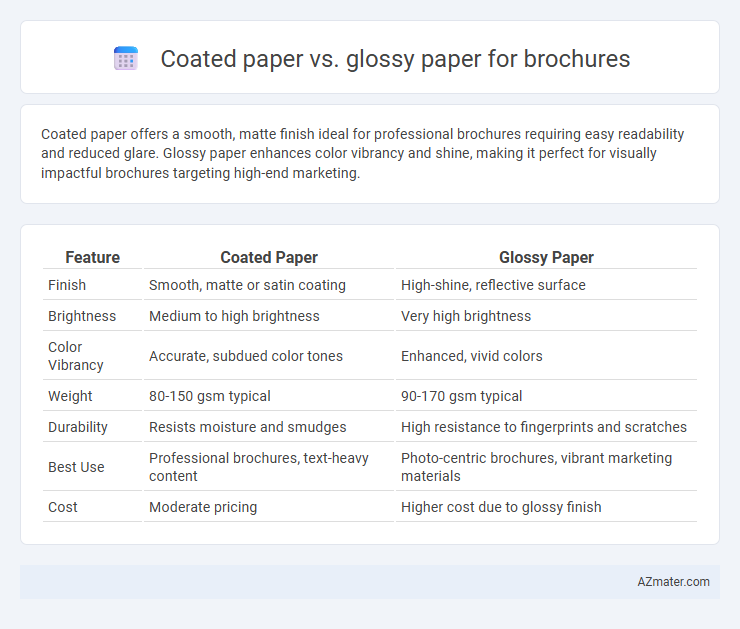Coated paper offers a smooth, matte finish ideal for professional brochures requiring easy readability and reduced glare. Glossy paper enhances color vibrancy and shine, making it perfect for visually impactful brochures targeting high-end marketing.
Table of Comparison
| Feature | Coated Paper | Glossy Paper |
|---|---|---|
| Finish | Smooth, matte or satin coating | High-shine, reflective surface |
| Brightness | Medium to high brightness | Very high brightness |
| Color Vibrancy | Accurate, subdued color tones | Enhanced, vivid colors |
| Weight | 80-150 gsm typical | 90-170 gsm typical |
| Durability | Resists moisture and smudges | High resistance to fingerprints and scratches |
| Best Use | Professional brochures, text-heavy content | Photo-centric brochures, vibrant marketing materials |
| Cost | Moderate pricing | Higher cost due to glossy finish |
Introduction to Coated and Glossy Paper
Coated paper features a smooth surface achieved through a layer of coating materials such as clay or polymer, enhancing print sharpness and color vibrancy. Glossy paper, a subset of coated paper, provides a high-shine finish that accentuates images and text with vivid contrast and a reflective surface. Both types improve print quality for brochures, but glossy paper offers a more eye-catching and polished appearance ideal for marketing materials that require striking visuals.
Key Differences Between Coated and Glossy Paper
Coated paper features a smooth, matte or satin finish that enhances readability and reduces glare, making it ideal for brochures with extensive text and detailed graphics. Glossy paper offers a shiny, reflective surface that intensifies colors and sharpens images, perfect for vibrant, eye-catching brochure designs. Key differences include coated paper's subtle texture and anti-glare properties versus glossy paper's high sheen and color vibrancy, influencing the brochure's visual impact and usability.
Print Quality Comparison
Coated paper offers a smooth, matte finish that enhances color accuracy and sharpness, making text and images highly legible in brochure printing. Glossy paper delivers vibrant, high-contrast visuals with a shiny surface that intensifies colors and creates a premium look but can cause glare under bright lighting. Print quality on coated paper excels in reducing reflection and maintaining detail clarity, while glossy paper emphasizes color saturation and shine, influencing the overall visual impact of brochure designs.
Durability and Longevity
Coated paper offers superior durability due to its protective layer that resists moisture, fingerprints, and smudges, making it ideal for brochures requiring long-term use. Glossy paper provides a shiny finish enhancing color vibrancy but is more prone to scratches and fading over time. For brochures demanding longevity and rugged handling, coated paper ensures sustained quality and appearance.
Cost Considerations
Coated paper generally offers a more cost-effective solution for brochures due to its lower production expenses compared to glossy paper, making it ideal for large-volume printing. Glossy paper tends to be pricier because of its high-gloss finish and enhanced visual appeal, which can increase material and ink costs. Businesses often weigh the budget constraints against the desired aesthetic impact when choosing between coated and glossy paper for promotional brochures.
Color and Image Reproduction
Coated paper offers a smooth finish that enhances sharpness and color vibrancy, making it ideal for detailed brochure images requiring precise color reproduction. Glossy paper provides a reflective surface that intensifies colors and contrasts, producing visually striking photos with a polished look. For brochures prioritizing vivid color and high-resolution image quality, glossy paper delivers a more dynamic and eye-catching presentation.
Texture and Feel
Coated paper offers a smooth, matte or semi-gloss finish that enhances readability with minimal glare, providing a soft and professional texture ideal for text-heavy brochures. Glossy paper features a shiny, reflective surface that intensifies colors and images, delivering a vibrant, sleek feel but can be prone to fingerprints and glare under bright light. Choosing between coated and glossy paper depends on the desired tactile impression and visual impact, with coated paper appealing to a subtle, refined touch, while glossy paper emphasizes bright, eye-catching visuals.
Suitability for Different Brochure Types
Coated paper offers a smooth finish with reduced ink absorption, making it ideal for text-heavy brochures and professional presentations, while glossy paper enhances vibrant color reproduction and sharp images, perfectly suited for visually-driven marketing materials like photo-centric or luxury product brochures. The choice depends on the brochure's purpose: coated paper supports readability and a matte or satin look, whereas glossy paper emphasizes eye-catching visuals and a shiny, polished appearance. Understanding these differences ensures optimal material alignment with the brochure's design and communication goals.
Environmental Impact
Coated paper, often made with a clay or polymer finish, tends to have a less environmentally friendly manufacturing process due to the chemicals used in coatings, which can complicate recycling and increase landfill waste. Glossy paper, while visually striking for brochures, typically involves heavy use of plastic-based coatings that hinder biodegradability and contribute to pollution during production and disposal. Selecting recycled or sustainably sourced coated paper with eco-friendly coatings can reduce the environmental footprint compared to traditional glossy paper options.
Choosing the Right Paper for Your Brochure
Coated paper offers a smooth, matte finish that reduces glare and enhances readability, making it ideal for brochures with detailed text and professional designs. Glossy paper provides a shiny, reflective surface that intensifies color vibrancy and image sharpness, perfect for visually striking brochures with high-quality photographs. Selecting the right paper depends on your brochure's purpose: coated paper suits corporate or informational materials, while glossy paper elevates promotional brochures needing visual impact.

Infographic: Coated paper vs Glossy paper for Brochure
 azmater.com
azmater.com